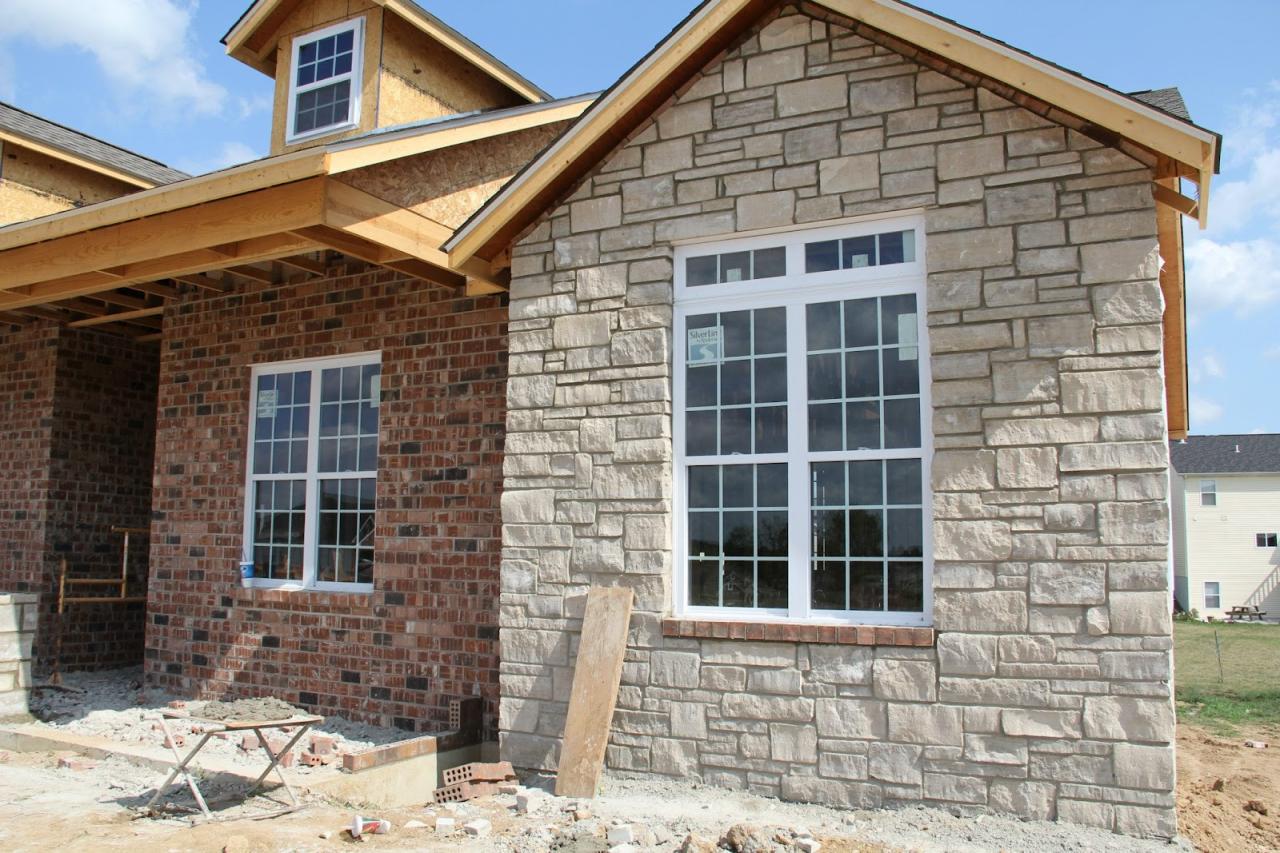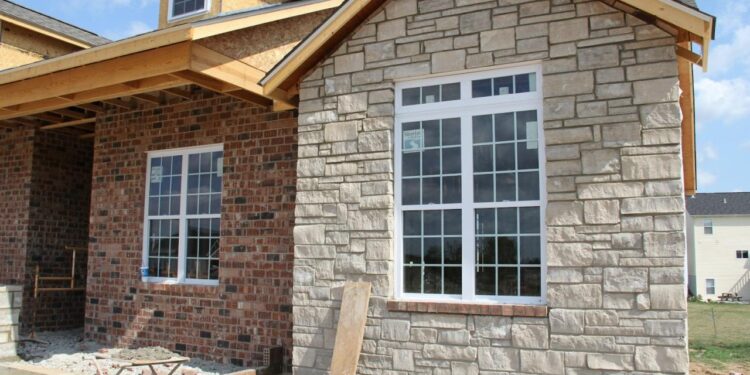As brick and siding exteriors become increasingly popular in modern architecture, this guide dives deep into the world of exterior cladding, offering valuable insights and tips for creating a stunning facade that stands out.
From exploring different materials to discussing design considerations and installation techniques, this comprehensive overview covers everything you need to know about enhancing your home's exterior with brick and siding.
Introduction to Brick and Siding Exterior
A brick and siding exterior refers to a building facade that combines both brick and siding materials for cladding purposes. This design choice offers a blend of aesthetic appeal, durability, and functionality.
There are several benefits to using brick and siding for exterior cladding. Brick provides a timeless and classic look, while siding offers versatility in design and color options. Together, they create a visually appealing and durable exterior that can withstand various weather conditions.
Popularity of Brick and Siding Exteriors
In modern architecture, brick and siding exteriors have gained popularity due to their ability to combine traditional and contemporary elements seamlessly. The contrast between the two materials adds depth and texture to the facade, creating a visually striking appearance.
Types of Brick and Siding Materials

Brick and siding materials play a crucial role in the exterior design of a building, providing both aesthetic appeal and functional benefits. Let's explore the different types of bricks commonly used for exteriors and various siding materials such as vinyl, wood, fiber cement, and stucco.
Types of Bricks
Bricks are a popular choice for exterior walls due to their durability and classic look. Common types of bricks used for exteriors include:
- Clay Bricks: Traditional and versatile, clay bricks offer a timeless appeal and are known for their ability to withstand harsh weather conditions.
- Concrete Bricks: Made from a mixture of cement, sand, and water, concrete bricks are durable and come in various colors and textures.
- Brick Veneer: Thin slices of clay or concrete bricks applied to the exterior wall to give the appearance of a solid brick wall without the added weight.
Siding Materials
Siding materials are designed to protect the exterior walls of a building from the elements while enhancing its visual appeal. Here are some common siding materials and their characteristics:
- Vinyl Siding: Affordable, low-maintenance, and available in a wide range of colors and styles. However, it may fade over time and is prone to cracking in extreme weather conditions.
- Wood Siding: Provides a natural and rustic look, but requires more maintenance in terms of painting, staining, and protection against pests and rot.
- Fiber Cement Siding: Durable, fire-resistant, and can mimic the look of wood or stucco. It is low maintenance but may require repainting over time.
- Stucco: Made from cement, sand, and lime, stucco is a versatile siding material that is durable, fire-resistant, and can be textured for a unique finish. However, it may develop cracks over time and require patching.
Each type of brick and siding material has its own set of advantages and maintenance requirements, so it's essential to consider factors such as climate, budget, and desired aesthetic when choosing the right materials for your exterior.
Design Considerations for Brick and Siding Exteriors
When it comes to designing the exterior of your home with brick and siding, there are several key considerations to keep in mind to achieve a cohesive and visually appealing look. From choosing the right colors and textures to coordinating materials effectively, each decision plays a crucial role in the overall design.
Choosing the Right Brick Color and Texture
When selecting brick for your exterior, it's essential to consider the overall style of your home and the surrounding environment. Choose a color that complements the existing elements of your house, such as the roof, windows, and landscaping. Additionally, pay attention to the texture of the brick, as it can impact the overall aesthetic.
Smooth bricks offer a more modern look, while textured bricks can add depth and character to your exterior.
Coordinating Siding Colors with Other Elements
Coordinating the color of your siding with other elements of your home is crucial for a cohesive design. Consider the color of your roof, trim, doors, and any other exterior features when choosing a siding color. Opt for complementary or contrasting colors that enhance the overall look of your home
Take into account the architectural style of your house as well, as certain colors may be more suitable for specific designs.
Mixing Brick and Siding Materials
Combining different materials, such as brick and siding, can create a dynamic and visually interesting exterior. When mixing brick and siding, consider using contrasting colors or textures to create a striking look. For example, pairing a smooth brick with a textured siding can add depth and visual appeal to your home.
Experiment with different combinations to find the perfect balance that suits your home's style and enhances its curb appeal.
Installation and Maintenance

When it comes to installing a brick and siding exterior, there are several key steps involved to ensure a successful outcome. Proper maintenance is also crucial to keeping your brick and siding exteriors looking their best and prolonging their lifespan.
Let's dive into the details of installation and maintenance for brick and siding exteriors.
Installation of Brick and Siding Exterior
- Prepare the surface: Before installing the bricks and siding, make sure the surface is clean, dry, and free of any debris.
- Install the moisture barrier: A moisture barrier is essential to protect the exterior from water damage. It should be properly installed to prevent any water infiltration.
- Begin laying the bricks or siding: Follow the manufacturer's instructions for the specific type of bricks or siding you are using. Make sure they are properly aligned and securely attached to the surface.
- Finish with proper sealing: Once the bricks and siding are installed, apply a sealant to protect them from the elements and enhance their durability.
Maintenance of Brick and Siding Exterior
- Regular cleaning: Keep your brick and siding exteriors clean by washing them with a mild detergent and water to remove dirt and grime.
- Inspect for damage: Regularly inspect the bricks and siding for any cracks, chips, or signs of wear. Address any issues promptly to prevent further damage.
- Repainting or sealing: Over time, the paint or sealant on the bricks and siding may wear off. Repaint or reseal as needed to protect them from the elements.
- Trim vegetation: Trim back any vegetation growing near the exterior to prevent damage from roots or branches.
Common Issues and Solutions
- Efflorescence: Efflorescence, a white powdery substance that can appear on bricks, can be removed using a mild acid solution and proper cleaning techniques.
- Mold and mildew: To combat mold and mildew growth on siding, use a mixture of water and bleach to clean the affected areas.
- Cracks and gaps: Fill in any cracks or gaps in the bricks or siding with an appropriate sealant to prevent water infiltration and further damage.
Summary
In conclusion, a well-designed brick and siding exterior can elevate the curb appeal of any home while providing durability and timeless beauty. With the right materials and design choices, you can transform your house into a masterpiece that exudes charm and sophistication.
Common Queries
What are the main benefits of using brick and siding for exterior cladding?
Brick and siding offer durability, low maintenance, energy efficiency, and a wide range of design options for enhancing the exterior of a home.
How do you choose the right brick color and texture for an exterior?
Consider factors like the style of your home, existing elements, and personal preference to select a brick color and texture that complements the overall aesthetic.
What are some common maintenance tasks for brick and siding exteriors?
Regular cleaning, inspecting for damage, repainting or sealing as needed, and addressing any issues promptly are essential maintenance tasks for keeping brick and siding exteriors in top condition.
Can you mix different types of brick and siding materials for an exterior design?
Yes, mixing brick and siding materials can create a visually appealing contrast and add dimension to the facade. However, it's important to ensure that the materials complement each other in terms of color, texture, and style.


